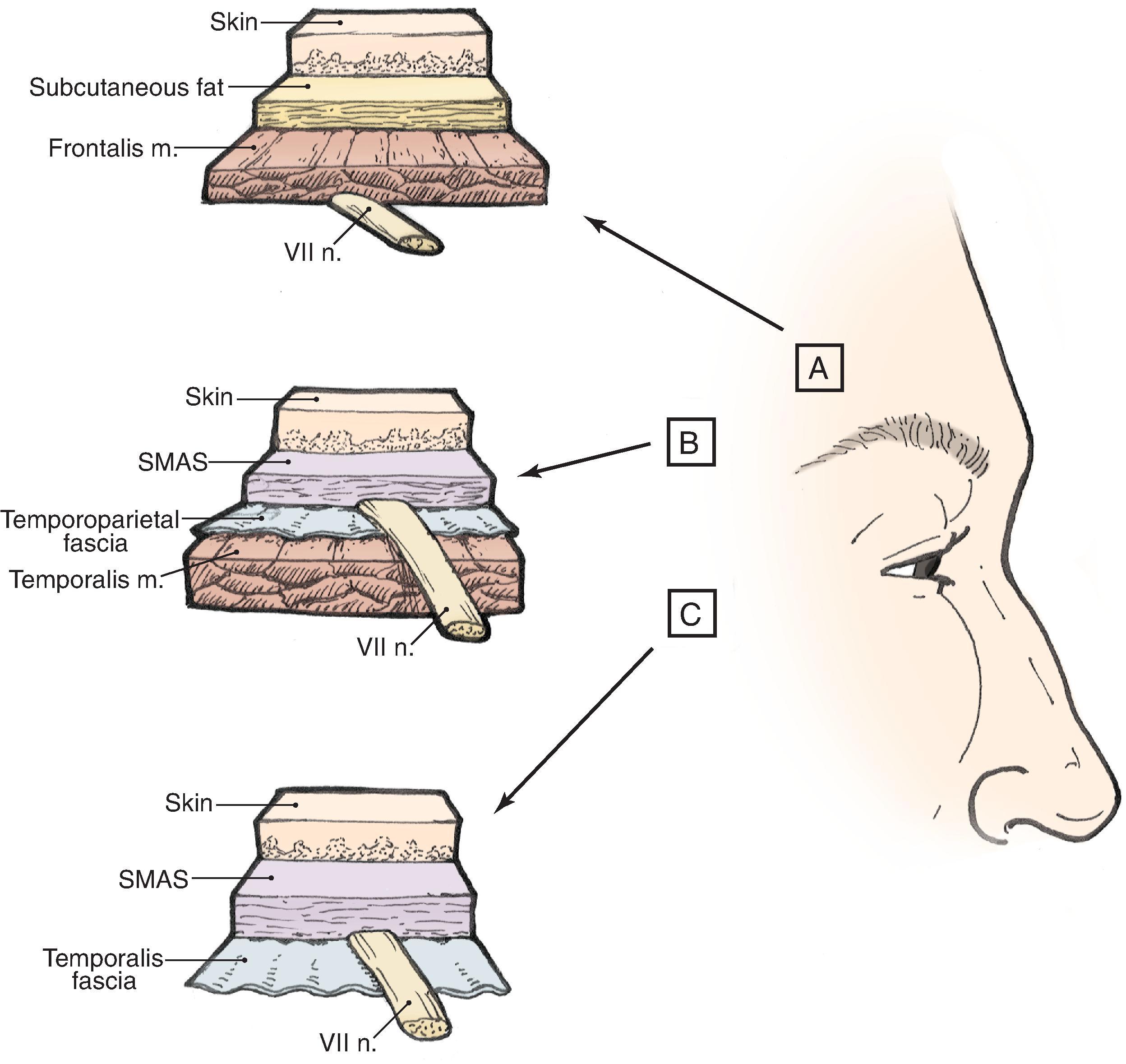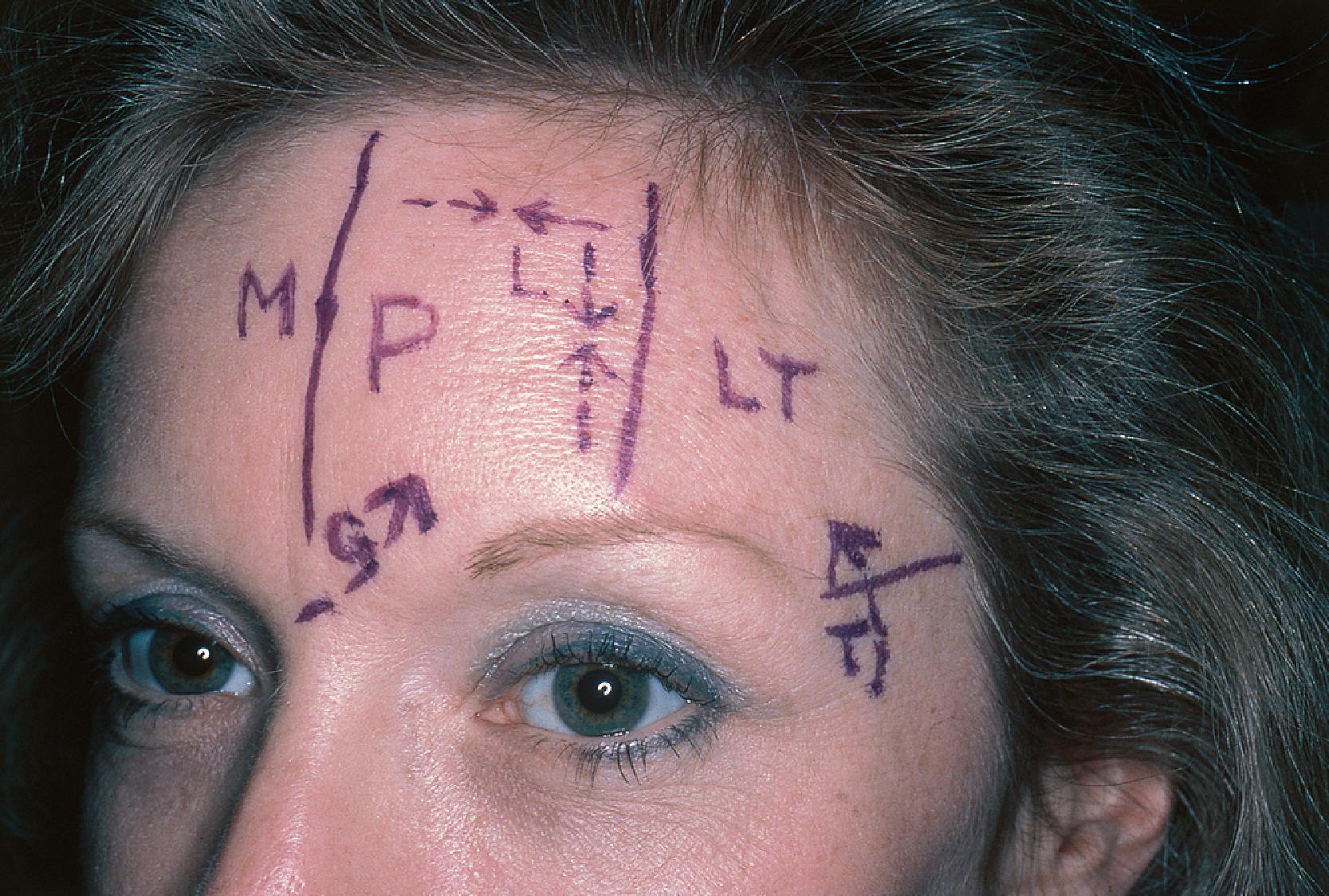Physical Address
304 North Cardinal St.
Dorchester Center, MA 02124
A paralyzed and ptotic eyebrow, an oblique midforehead scar, focal alopecia in a brow, an asymmetric hairline – for the skilled reconstructive surgeon these deformities would be considered complications of forehead reconstruction. For the unskilled and unknowledgeable surgeon these are more likely to simply be written off as common sequelae of reconstruction.
Reconstructive surgery of cutaneous defects of the forehead may be simple or complex. Several goals must be considered: (1) preservation of motor function (temporal branch of facial nerve) and, if possible, sensory nerve function; (2) maintenance of the aesthetic boundaries of the forehead, including position and symmetry of the eyebrows and the frontal and temporal hairlines; and (3) optimal scar camouflage by placement of scars in or adjacent to the hairline, eyebrows, and relaxed skin tension lines (RSTLs) whenever possible. This chapter reviews the anatomy of the soft tissue cover of the forehead and the principles of reconstruction of this aesthetic region of the face. The reader is also referred to a number of well-written review articles on forehead reconstruction, many of which this author has learned from and thus improved his expertise in reconstruction of this facial region.
The skin of the forehead not only varies from person to person but also changes notably with aging and exposure to the sun. Beginning in the suprabrow area and moving toward the anterior hairline, forehead skin dermal thickness and sebaceous gland concentration decreases. This is manifested by a decreasing skin thickness and a less porous, less oily skin. In youth the forehead skin is taut and smooth, with a shiny appearance. In contrast, older or sun-damaged skin has an increased mobility, a dull appearance, and rhytids. Although aesthetically compromising, these latter features all facilitate reconstructive procedures.
The predominant muscle of the forehead aesthetic region is the anterior belly of the occipitofrontalis muscle. The vertical orientation of the skeletal muscle fibers is responsible for the transversely oriented RSTL. Often quite prominent in younger individuals, the muscle thickness diminishes substantially with age. Extensive cutting of this muscle during reconstructive procedures may cause local palsies that have a prolonged recovery. Also of note is the often present anterior extension of the galeal median raphe. This fascial extension in the midforehead is devoid of muscular fibers and accounts for the often excellent aesthetic result that is attainable with vertical midline wound closures of the forehead. The other muscles in the forehead region include the orbicularis oculi, procerus, and corrugator supercilii. As a rule, transection of portions of these muscles is without major consequence.
The forehead is a richly vascularized region. Centrally it is supplied by the right and left supratrochlear and supraorbital arteries and laterally by the anterior branch of the temporal arteries. These vessels are located in the subcutaneous tissue and are very predictable in their location. Transection of these vessels during the elevation of random-pattern cutaneous flaps should not be of any major consequence because of the ample collateral circulation of forehead skin.
Loss of nerve function, whether motor or sensory, has great consequence to the patient. The motor nerve to the frontalis muscle is the temporal branch of the seventh cranial nerve ( Fig. 21.1 ). This nerve innervates the entire frontalis muscle and is most at risk for injury during flap elevation, not on the forehead but rather over the zygomatic arch and in the temporal area. The thin skin and subcutaneous tissue in these areas cause the nerve to be close to the skin surface, particularly in thin or aged individuals. Development of flaps in the temporal region may transect the nerve if not cautiously elevated. Upon reaching the forehead, the nerve enters the frontalis muscle from its deep surface, and inadvertent transection of the nerve is much less likely. To prevent motor nerve injury, dissection of local cutaneous flaps of the forehead should be in the subcutaneous tissue plane or below the frontalis muscle and above the periosteum of the frontal bone.

The major sensory nerves of the forehead are the supraorbital and supratrochlear nerves, which run with their named arteries. After exiting their foramina in the sub brow area, they pierce the overlying muscle and extend cephalad in the subcutaneous tissue. Transection of these nerves yields anesthesia distal to the point of injury. The anesthesia may extend posteriorly to the level of the parietal scalp. The numbness perceived by the patient is not only annoying but also potentially harmful because of loss of normal sensory feedback. To prevent sensory nerve damage when dissecting forehead cutaneous flaps, it is essential that the surgeon carefully undermine skin flaps in the superficial subcutaneous tissue plane. For larger flaps developed below the muscle, consideration should be given to placement of incisions peripheral to the path taken by these nerves.
The first goal of forehead reconstruction is to maintain motor and sensory nerve function. Knowledge of forehead anatomy and proper flap design will help accomplish this goal the majority of the time. In some instances, sensory nerves will require transection, particularly when reconstructing large skin defects, but this should be done only if no other effective reconstructive alternative is available. The surgeon should not burden the patient with a motor or sensory nerve deficit in exchange for a less complex reconstructive procedure that requires transecting important motor or sensory nerves. The compromised function of a nerve, particularly motor, should never be considered a routine consequence of reconstruction of the forehead. Regrowth of sensory nerves can be anticipated; however, complete transection of the supratrochlear or supraorbital nerves results in anesthesia of the distal forehead and scalp commonly lasting for one or more years.
Occasionally the surgeon is confronted with cutaneous defects of forehead skin in which the facial nerve branch to the frontalis muscle has been cut, yielding a ptotic eyebrow, facial asymmetry, and occasionally visual field limitation on upward gaze. Not all individuals are functionally compromised by a paralytic eyebrow ptosis. If individuals wear eyeglasses, they may adequately camouflage the appearance of a ptosis with their eyeglasses and the ptosis will not require surgical repair. For those situations with functional or significant aesthetic alteration, however, there are several techniques available to unilaterally elevate the eyebrow. The author most commonly performs a direct eyebrow lift in which an ellipse of skin is resected from the suprabrow area to elevate the eyebrow approximately 4 to 8 mm higher than the opposite eyebrow. The greater the laxity of the forehead skin, the greater the need to overcorrect the elevation. The inferior border of the skin ellipse is incised along the superior margin of the eyebrow parallel to the axis of the hair shafts. Horizontal mattress suspension sutures are placed between the sub brow dermis and the forehead periosteum. Nylon sutures (5-0 clear) are passed through the periosteum approximately 1 cm above the desired point of eyebrow elevation.
Repair of the skin incision then follows with a layered closure, preferably using intracuticular suturing techniques. A second alternative for correction of eyebrow ptosis is to perform a procedure similar to a direct eyebrow lift but incisions are made in the midforehead, thereby camouflaging the incisions in the horizontal creases of the forehead skin. Coronal forehead lifts for correction of unilateral eyebrow ptosis are rarely indicated.
In the last two decades, the concept of facial aesthetic regions has greatly simplified and, more importantly, improved the outcome of facial reconstructive procedures. Facial aesthetic regions have borders that must be maintained to ensure facial symmetry. As a rule, a given aesthetic facial region is covered with skin that has identical or similar characteristics throughout. If “neighborhood skin” within the same aesthetic region can be recruited to repair a skin defect, optimal aesthetic results may be obtained. The forehead facial aesthetic region is defined peripherally by the juncture lines with the frontal scalp superiorly, the temporal scalp and temple laterally, and the eyebrows and glabella inferiorly ( Fig. 21.2 ). The forehead is somewhat different from other facial aesthetic regions in that it has both an actual and perceived boundary line. Hairstyling can play a major role in forehead visibility. Bangs or a sweeping hairstyle can be used to cover all or part of the forehead. Thus hairstyling may be used to camouflage a large area of forehead scarring and disfigurement.

In planning reconstruction of a cutaneous forehead defect, the surgeon must first ask what the aesthetic goals are. The specific aesthetic goals for forehead reconstruction include: (1) maintenance of eyebrow symmetry; (2) maintenance of natural-appearing temporal and frontal hairlines; (3) when possible, positioning scars adjacent to or in hairlines and eyebrows; (4) when possible, creation of transverse rather than vertical scars (except in the midline); and (5) avoidance of diagonal scars.
Become a Clinical Tree membership for Full access and enjoy Unlimited articles
If you are a member. Log in here